Sunday, September 12, 2010
Easy Ezines
And isn't that so baby boomer -- matchbook covers.
For those born too late, these were thin packets of matches in folding covers of pliable cardboard. They existed before disposable lighters, which existed even before "non-smoking" sections were partitioned off from a worldwide swath of smokers. Now it's the opposite.
The matchbook covers were anchored with a striking section from which sprouted a score of sulfur tipped, cardboard matches. The exteriors could sport brilliant promotional art. Sometimes, on the interiors of the covers, were printed advertisements for the secret of turning a 98-pound weakling into Atlas, permanent hair removal, mail-order programs to obtain an engineering degree or home courses to learn dentistry or secretarial skills. I'm sure I ran across one or two that promised a publishing house would read my novel.
It was assumed, back when matchbook covers promised new careers and wealth and baby boomers were getting the best education tax dollars could buy, that only desperate, gullible people answered these calls.
It's not like I'm eating cat food, but even with my college degree and graduate credits, last week I tore off the flap of the ezine matchbook cover and sent it in.
This, insists my marketing guru, is the first step toward building a destination Internet site. Which is, by the way, www.vikivolk.com.
I think that is the point. Usually when I reach this point of understanding someone shrugs and says, "It's the Internet. Who knows?"
So, next ezine step is writing 10 (?!?TEN?TEN! 10 !TEN?TEN?!?) feature-y, newsy stories about how to do something that someone else wants to learn how to do via the Internet. So there's the focus. "Who knows?"
In the philosophical realm ezines mean giving away work for free. Which, yes, this here is free as well, but it seems different somehow when I push "publish post" versus someone else. Call me a dilettante, but I see a difference.
Either way, my colleagues rightfully fear what happens to value with product cost at virtual zero.They already see me as crazy and detrimental to the cause. This ezine plummet could confirm their worse professional fears for me. Obviously, there is shame. I can only hope on both sides.
As if the whole self-publishing concept isn't shocking enough. The notion of publishing work un-vetted, let alone unedited, is stomach turning to baby boomer journalists, those old enough to have watched "All the President's Men" in real-time.
Which, btw, is so Old-timer today. Which, further-btw, means aspiring New-timers, please, comment on 10 things you want to know.
Take that step into the New-Age, record a Comment here. Help an old journalist make a buck. "Who knows?"
Friday, September 10, 2010
Burning Bibles and Qurans
In my callow youth yelling fire in a theater universally denoted the limits of the First Amendment. Watching other lines of our First Right waver was the evening news of my Baby Boomer life. But I never heard tell of that original principle being abandoned.
But this past media week makes me think such limits have been lifted. So when did it become legal to incite violence? Before or after 9/11? It wasn't that way when I was coming along. Back then you could arrest non-violent protesters for inciting violence. Now it seems more illegal to conspire to commit treason than incite violence. How did that happen?
Another thing I don't get, what does it mean to burn someone's religious book? Is it like burning a flag? Which, by the way, is really confusing in America where burning the flag is both the correct and incorrect way to get rid of one. So that means, in America, with flags, it’s the intent that determines the criminality – or not – of the act. So maybe with flags it's sort of like conspiring. It's the part in your mind that is illegal.
The "will-I-won't-I" Quran burning is more like inciting than conspiring, the proverbial lighting of the match. Is holy-book-burning then an extravagant spit in the face? Could we counter it with a bigger spit? Facing off with a couple dozen Gideon's?
No. It could only work if the Bible burning were an offering of some sort, to peace I suppose. Burning with sneers on our faces is merely a tit for tat, or spit for spat as the case may be. And that is so obviously the problem, not the solution.
I don't propose burning Bibles as an anti-Christian gesture, more an attempt to balance the fallout. I've no disrespect for the Bible, a great book, it guided my upbringing and life values, however poor my adherence. Indeed, it is perhaps shoddy understanding that leads me to think that using the Good Book in any way to defuse hatred would be considered Good Works.
I specifically chose the Gideon’s Bibles because they seem the most nondescript. I don’t propose to offer the small white Bible my mother carried at her wedding and I carried to a smattering of Protestant Sunday schools throughout my childhood. No one suggests you give up something personal when dealing in symbolism.
Maybe that's why symbolism never works well for me at a burning -- be it a flag or an effigy or a book or a whole city -- I have a hard time grasping the philosophical from video of hotly led and undisciplined hooligans with no stake in their wake.
It always seems to me, sitting at a slight remove from my television, we have the stake in this wake, we theater-goers who had planned, at the end of the show, to make dinner and get on with it. We hadn't planned to bump up against a band of hooligans playing irresponsibly in the public streets attempting to set-off the Apocalypse.
So here I am, at my great remove, slack-jawed with wonder. If regulatory stop work orders halt bulldozers, court orders protect threatened individuals, how can there be no Homeland Security measure to protect America from a band of hooligans screaming fire in a crowded theater?
For that matter, when will the public health laws kick in? I thought in America we provided protective confinement for people in imminent danger of harming themselves and others.
Monday, September 6, 2010
What's Funny About Labor Day?
Indeed, as I write from the lap of paradise, two jet skiers sputter past. The riders are middle aged. Middle-aged and very sweet to one another. "Do you want to go in first?" asks the man looking back at the woman. "Oh, no, you go on," she says. I wonder if this means they are married or if they are not.
It's easy to hear their conversation and even establish the emotional tone because not only do voices carry well over water but people are typically screaming in a normal voice when a motor is running beneath them.
Come to think of it that also applies to bankruptcy, politics and governing. Or sort of: The natural voice is screaming as the motor of bankruptcy/politics/governing revs beneath them. I wonder if screaming pleasantries could be just as satisfying as screaming anything else.
I have been wanting to scream lately. Remember Primal Scream Therapy? Popular back when we Boomers were still in full possession of our own hearing. It sounded appealing then and sounds appealing now. A couple quick clicks assure me it is still available, Google and Wikipedia are all over it. But the potential humor doesn't draw me, I don't click further. I don't want therapy. I just want to scream.
I would like to scream: Stop! Wasting! My! Time!
The screaming itself might be good therapy. Baby Boomer Girls in my years were raised to fight stealthily and from the flank. We were advised to have a "good cry" over rejection, disappointment, apprehension, loss or disaster to purge ourselves of grief.
Lately crying seems the last possible reaction I could muster from any of those things. A good scream seems much more likely to provoke catharsis. That's what I want.
And then I want to go back to the garden Joni Mitchell was singing about on our way to Woodstock. Remember back when our full concept of "time" was captured in that song?
"Is it the time of year? Or is it the time of Man?"
Women were so young back we weren't even called women yet. We didn't even know to ask, "Is it the change of life?"
So not too far a metaphoric reach: Wanting to capture fleeting time as I write from the lap of paradise on Labor Day, the end of summer. Hard to be a Boomer of my years and miss the middle-aged metaphor there.
Oh no! Not another middle age crisis? It always feels that when the first of the Boomers go through it we're all over it. I think I just really want to scream to stop wasting time, regardless of whether its the time of man, time of day, time to write the great American novel or too late to even read it.
What do we know about it anyway? Ah, there's that famous rub. We know only that we don't know when or how. And now it's the end of summer and we're reckoning? Sheesh, is this as light as Labor Day can get? I might as well go back to bankruptcy, politics and government.
Thank goodness, here come the middle-aged jet-skiers again.
Mostly it's young kids screaming in and out on the jet skis. I clench my teeth and think how rare anyone gets out on the water for a rewind, reset, re-framing of the careening movie that is our life. The machines are nothing but mechanized dinosaur mosquitoes, whining and penetrating every crevice of hearth and home. But it is the lap of paradise and we creek dwellers have little right to whine ourselves.
So this couple puttering along, albeit at jet ski decibel, have a charm. They are wearing matching flotation vests, slimming in black. She appears to have the same armor plated long skirted swimsuit I got from Land's End Overstock last year. And that is not merely endearing but reassuring. I know that no matter what, she won't want to fall off that dinosaur. That suit has enough fabric to it to sink when it gets wet.
She screams across the creek, "Isn't this great?"
I think that's what I'll start screaming. Couldn't hurt.
Sunday, August 29, 2010
Leaving Salvador Dali's House

Of course. How else would it be? At its most concrete, time is ephemeral; once an instant passes, once a breath passes, then the time of now is gone.
when that breath was,
that is what time becomes.
Here and now
whatever time was
time is now ago
And there it will stay forever.
But is it gone?

The heads atop Salvador and Gala Dali's home still overlook the Mediterranean Port Lligat, even if the lens that captured this moment is not there.
They are there.
Now.
They are not ago.
This photograph is real,
right now.
Now.
You can't really help yourself thinking like this after you've been to Salvador Dali's house, the timelessness of it is omnipresent. Rock. Sea. Sun.
Surrealism arrived about the time scientists started adding dimensions to the long held Reality of Three. Come to find out, as the 20th Century rolled along, Time, the absolute yardstick of Life, and thus of Death, was bendable.
Up until then Life was measured in what seemed a one-dimensional way, Time was so one dimensional it wasn't even considered a dimension. Then, Wham!
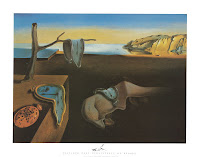
Not only is Time dimensional, it's such a flexible dimension it can verily double back on itself.
Freud,
 whom Dali called "my father," found the same thing in the human psyche: Time stretches -- forward, backward, every which where. Memory, conscious and un-, overtakes even the all-powerful present and spills forward into dreams, and obsessions, carving out needs even before desire arises; shaping our destinies.
whom Dali called "my father," found the same thing in the human psyche: Time stretches -- forward, backward, every which where. Memory, conscious and un-, overtakes even the all-powerful present and spills forward into dreams, and obsessions, carving out needs even before desire arises; shaping our destinies.Dali's best known canvas is about Time and titled The Persistence of Memory.
Perhaps there is no true leaving of Salvador and Gala Dali's house.
It is like the inside of a very bright egg, a stucco cocoon full of open-air windows.
The eccentric couple bought it as a fisherman's hut in 1930 and began shaping it around themselves.
Although shuffled in
 , shuffled through, shuffled out the door,
, shuffled through, shuffled out the door,the timelessness of sea and sun and stone remains. Either in memory or planted by Dali whose so named "Paranoid Critical Method" called upon his own "irrational knowledge" to trigger the release of others' -- this was the method to seeing Reality in its multiple Dimensions. Surreal.
The home is as though stucco grew around the light and sheltered the correct womb for Dali's studio, rigged for accommodating even huge canvases; then a few stucco stairs -- this is all white. White, white, white, white -- and it is the right place for the shelf for the stuffed swans and there a small altar space for some shells.
It is right to say Dali's home/studio grew organically -- as if the stucco grew around Dali's outrageous genius made live from the brimming brew of the omnipresent Gala.
Just to convey again: The ceiling, the stairs, the walls are white. They are white, white, white, white, white.

 It is the same white hot light inside as out.
It is the same white hot light inside as out.Egg atop the summer dining room
Anchors the courtyard.
Birth.
Sun, sun, sun.
Sea, sea, sea.

Then inside, a grand piano, nestled and defunct within crumbling rock.
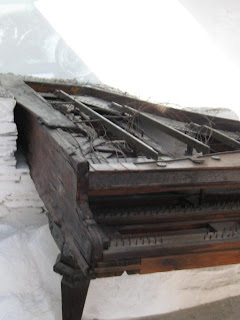
Meanwhile, playing on the white, white, white stucco wall is The Magician himself.
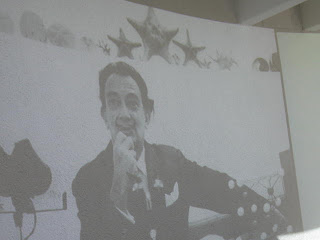
It would be easy to dismiss Salvador Dali on so many levels -- as George Orwell tried in 1946 in an essay discussing Dali's promiscuous and distasteful subjects:
He is a symptom of the world's illness. The important thing is not to denounce him as a cad who ought to be horsewhipped, or to defend him as a genius who ought not to be questioned, but to find out why he exhibits that particular set of aberrations.
But by the next decade, as time warped and dreams became potentially more real than what had once been Reality, Dali added complex mathematics and Einstein and DNA theories into the visionary work he produced on canvas and in objects; seeking to provoke in others the "irrational knowledge" that layers our Reality and telescopes our vision into other Dimensions.
Perhaps, to try to answer Mr. Orwell from this more distant vantage, from the future, Dali is trying to warn us of something.
Still.
Now.
Tuesday, August 24, 2010
... the continuing saga of the dinosaurs
When I merely had designs on Jackie Russell, my Cape Cod brother-in-law told me, "Fishermen don't know the difference between a woman and raw liver."
Indeed, women don't reckon for much on the Chesapeake Bay. To hear a waterman tell, they're bad luck aboard a boat and figure prominently in the three worst calamities to befall man: A leaking boat. A smoking stove. A nagging wife.
In self-defense, I'd heard only about the luck and the liver the day I endorsed gender bias for my editor.
He had walked past my desk and said, “If she asks, you have to tell her there are no waterwomen.”
“Waterwomen?” I trailed him across the bluish, threadbare, indoor/outdoor carpeting glued to the cement floor. “Who asks?”
"Mary Z."
The latest publisher. I joined the county’s newspaper of record in 1985. The buying and selling foretelling the end of what was then called legitimate journalism was well underway.
Mary Z had offered her initialized name acknowledging an awkward pronunciation. The newsroom had merely eyeballed one another. We'd never before dealt with last names, initialized or not. Or unless it was to denote by single name some so-christened reporter.
“Only if she asks,” my editor said. He was using his hands by now. They'd fallen naturally on top of an array of scribbled notes which he swept into a pile of privacy. These were the confidentialities he’d guaranteed safely ensconced, responsibly distributed, facts to be investigated. He expected his reporters could read upside down. When he opened his palms he offered a tight shrug. “I told her there were none. Absolutely none. None. Not a single woman working as a waterman on the Chesapeake Bay.”
The newsroom gauges the editor’s anxiety by the tightness of his squint. “There aren’t any, are there?” he asked. You could have blinded him with tooth floss.
“Why does she want to know if there are women watermen?”
“She wants to call them fisherfolk,” he said.
“Fisherfolk?” I squinted.
“Fisherfolk,” he said.
“She wants to call female watermen fisherfolk?”
“She wants to call all watermen fisherfolk.”
“No,” I said. No doubt a nervous giggle escaped. Or an expletive. “Oh, no. She wasn’t serious was she?”
“Yes. She was serious. She was very serious. Yes she was. I told her it was impossible, it was a traditional name of centuries, and she asked if there were any women.” He paused. “I told her there were absolutely no women working on the water. Not one in the entire Chesapeake Bay.” He paused again. "And that I would check with you."
I would never have another date with Jackie Russell if my newspaper called him a fisherfolk.
The editor was silent and we looked at one another with narrowed eyes.
“Jackie Russell would agree with that,” I said.
“Yes. That’s what I told her,” he said.
Everyone in the newsroom heard this. The editor’s office consisted of four partitions, a door and no ceiling. The box sat in the cavernous back stocking space of a cinder block retail shopping strip. No one said a word when I returned to my desk, nor for the months that followed of Mary Z's tenure. But when Mary Z stepped foot for the last time out the glassed front door the whoosh of air hadn't yet reached the far back newsroom when a reporter called out, "She wanted to call watermen fisherfolk!" The newsroom cracked up.
Jackie Russell didn’t think it was funny. We would have seen one another the following Saturday night -- date night -- from whatever day it was my editor had sought gender guidance. Like poking at a loose tooth I naturally told him about saving the paper from fisherfolk. He didn't think it was funny at all.
Back when journalism was rated legitimate or non- we were the keepers of a very non-virtual century of our community's yellowing and crumbling archive of a world almost fully disappeared. We strove to shield the paper from ridicule from its loyal readers – the vanishing natives of St. Mary’s County – although few of them would believe such a thing of us. Many of our vanishing readers still considered “The Enterprise” the bastard paper. Thankfully indignation and outrage spurred them to plunk down increasing amounts of silver twice a week for the privilege of hating us.
We all understood why Jackie Russell wouldn’t think it was funny. Extinction isn’t funny. Coating a tradition as steeped in lore and legend as Chesapeake Bay watermen with something that sounded like a new display at the Small World ride in Disneyworld wasn’t going to translate well.
Back then the newsroom kept a bank of old filing cabinets with two drawers dedicated to the black and white photographs of people who made news. Many of the photos were still attached via rubber cement to stiff layout paper where every sentence and photo was arranged by hand less than five years earlier.
Back there, rifling through the "R" manila envelope, looking for a Raley or Ridgell, Jackie Russell manifested. The photo had been taken that first day I had met him, when I‘d just begun at the radio station, before I’d run thousands of miles away from St. Mary’s County and he'd called me back.
Later I would take the whole envelope back to my desk until finally I left the photo there. I eventually took it home. It was too old a photo by then to be newsworthy. By then Jackie Russell and I shared a home. I didn't write about the fisheries anymore. It’s probably still around here, somewhere. That photo.
When I first wrote down this fisherfolk story, during the years Jackie Russell turned from waterman to educator, I didn’t ask him again about fisherfolk. He can laugh about it now, the insult so far away the humor is more accessible. Still, I told him about the photo.
There was no point saying it was the day we met. Tell him instead the boat is leaking you want a reaction. “It was when you were chairman," I prodded, pushing at that loose tooth.
He thought back to the days he cast judgment upon the fisheries of the Potomac River and the watermen who made their livings from them.
“And we really thought we were doing something,” Jackie Russell said of that day, the day of that photo. He exhaled a heavy sigh before turning his back and asking to be spared any more narrative tonight, asking, instead for the peace of sleep.
“We really thought we were doing something,” he repeats and heaves his great sigh again, without self-consciousness, without awareness of his own melodrama.
“Trying to prevent this day from ever coming,” he says. “Right now.”
Tuesday, August 17, 2010
Unbelievable! Watermen Working In Tandem
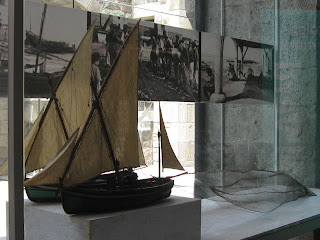
dragging a purse net between them.

The boats worked the Catalan coast,
explained the exhibit,
as the farmers worked the land; thus
Dragnet Boats were also called Ox Boats.
The season ran September through March with the crews at sea two to three days at a time, according to the description below the model displayed at the Maritime Museum at the Barcelona Port. There could be several daily catches.
Centuries ago the process was criticized for its effect on marine life preservation. The seining would "drag up all kind of fish and other animals without discrimination scraping over the sea bottom."
Also displayed was a Trawler and Lamp Boat. The exhibit said the use of artificial light to fish is "very ancient." The use of torches was recorded as early as the Middle Ages in Catalonia.

A model of a Mediterranean trawler from the Catalonia coast. The lamps on the trailing Lamp Boat are almost more obvious in reflection off the glass case.
The exhibit marvels at the unusualness of a technique employed along the Catalonia shore originated in the New World. "Purse seine netting by trawlers is a fishing technique imported from the American coast" with its first recorded in use around 1825 in Rhode Island.
I admit it. I was proud. That's my Atlantic coast.
Sunday, August 15, 2010
DON'T LEAVE HOME WITHOUT YOUR PRESS PASS
How many times have I told students, even their high school newspaper's press pass carries weight. Everybody, everybody, EVERYBODY wants to talk about themselves to a professional listener.
And although my hair is still dark and my face somewhat leaner in the laminated photograph, I do have a press pass and -- albeit from a company no longer in business -- IT WOULD HAVE WON ME THE RESPECT OF THE GATEKEEPER OF SALVADOR DALI'S HOUSE.
His house.
But no. I didn't listen. I pulled that ancient old laminated press pass out of my wallet more concerned with the Tel Aviv airport than thinking about Salvador Dali. I took it out of my wallet and I KEPT IT AT HOME! Digging before the gatekeeper I discovered I had I kept my government pass in my wallet. WAS I CRAZY? No one in Tel Aviv asked me a thing about credentials. They just kept asking the origin of my name and if anyone had asked me to deliver a package out of the country. Then they'd asked me again, about 20 seconds later, like maybe it had slipped my mind.
How can I be offended by that. Obviously I am slipping. Turning into a non-journalist -- because who else would leave their press pass at home. So many of us former journalists are slipping -- some becoming flaks, others complete sleaze-bag journalists others sanctimonious. By this I mean, lean toward the sleaze-bag spirit of the old days and even if you have to use your kid's computer software and the laminate-kiosk at the nearest mall: DON'T LEAVE HOME WITHOUT YOUR PRESS PASS. We're talking about Salvador Dali's house.
Oh, and a small flashlight. Press pass or not, likely you're still in that economy hotel room down a hallway without a single electric light bulb. Some things change when you lose your credentials. Some things stay the same.
Old Ladies Can Still Solo -- SOLA -- to Europe
"Uh. No," I said, which are the same words or at least sufficiently similar sounds to apparently mean pretty much the exact same thing in all languages. "No," I said. I might have said it three times. What I thought was, thank god I got over here in time to clear that up. I'd made the right decision after all.
The decision was to solo Europe. I should have gone in the 70s with the rest of the boomers whom I'd always supposed had gone, smoked hash, met the Beatles and returned home to lucrative writing careers with Rolling Stone. But I stayed timidly home. Nor did I go in the 80s when, actually, I really should have gone. That was the decade I spent catching up on so many other things I'd missed in the 70s. The Divorced Years, by any other name. It didn't feel right to go alone. Shouldn't Europe be a honeymoon kind of place, or something? By the 90s, well, by then there were so many reasons not to go and having never been no confidence to bundle up a family of Americans into the unknowns of language, custom and passports.
Suddenly it's a good decade into serious middle age, a daughter spurs me into a ticket across the Atlantic, but then I was alone. And finally I come up with the motivating response: If not now, never.
Just Say Yes, is my new motto. And carry extra underwear. Everything else is exactly like you've always been told: half the clothes and twice the money. Remarkably, at the advanced age of a wife of Salvador Dali, the axiom works perfectly.
Saturday, August 14, 2010
A Few Minutes Before Midnight
A few minutes before midnight in the Tel Aviv airport, jetlagged already and awaiting another transatlantic flight I found myself confessing, again, the accusation that my generation abandoned the struggle for Justice to become insurance salesmen and grow houseplants. That’s how it would have been said back then, salesmen.
I confess this time to an intrepid young woman who’d asked permission to share a table then left her passport beneath her wallet at its corner as she returned to a kiosk to retrieve a bowl of soup rich with pesto. She had graduated a few months prior from boarding school and launched a “gap year” from the West Bank. In response to my praise of the soup she said life was more primitive where she had stayed. People made their food from scratch, she said. She expected to enroll next year in a conservative Jewish seminary school in New York.
I am meeting my daughter in the airport; she is a few years older than the future seminarian and has also been in Israel. Her time was spent within a multi-national project viewed with suspicion by Israeli officialdom. “My daughter is working for World Peace,” I tell this younger woman with the small ironic smile that provoked wry and slightly condescending smiles from my Baby Boomer peers back in America.
I tell the younger woman how glad I am to see young people getting back to our unfinished work on Justice. I tap my cell phone, worrying my daughter about the approaching boarding time. I mention Stuart Brand to the girl, the visionary scientist who grasped the significance of the first photograph from space of the entire planet which, Brand said, “gave the sense that Earth’s an island…” He coined not merely the phrase but the entire “Whole Earth” concept and led many of its earliest manifestations.
The message to us Children of the Sixties that We Are One wasn’t exactly taken to heart, I confessed.
It is 30 years since my accuser said we abandoned the struggle for Justice once we saw the price of war. He told me this the week John Lennon was shot, 10 years after Kent State where overly armed and undertrained Ohio National Guardsmen shot 13 students to rein-in protests against the Vietnam War. Four were shot dead. After that, he told me, my generation went home to sell insurance and grow houseplants. We didn’t merely capitulate; I inferred from this, we didn’t even stop at collaboration: We turned tail and returned to the lives of petty privilege feeding Injustice.
I wouldn’t need to explain Kent State to these two women; they’d been in Israel where overly armed men and women just their ages roam the streets. It would have been difficult to explain how it appeared back then that only men made war.
They would surely have grasped the quote from that time, “This is a nation at war with itself,” which Wikipedia attributes to a lawyer in the Nixon administration, but which was too broad a sentiment of the time to actually be accorded to only one man.
But as for One Earth – the Whole Earth – could they have grasped the significance of seeing for the first time our entire plant from outside, the recognition that we are not merely All One, it is actually a very tiny place. The first visualization of the mother planet, and she looked alone.
I offer none of these explanations. Instead I say of my accuser, “He lost his daughter and her family in 9-11.”
Why keep sharing this shard of guilt in the first place? And why now consistently endow it with the unrelated but somehow connected accumulated weight of 9-11?
And why in particular burden these fresh-faced women whittling toward World Peace? To assuage my own guilt? Simply because I had spent 13 hours in mind-numbing pettiness trying to move harmlessly and unharmed through Israel for no other purpose than to get home. I had not even been long in Israel. I had spent the weeks touring lovely European seashores and museums. I had bought my daughter a T-shirt of Pablo Picasso’s “Don Quichotte.”
Was that it? Simple but now compounded guilt?
It is time to seek our boarding gates. She has finished her soup and would like a polite way to exit. I am texting my daughter that it is time to board. All of this and a large glass of wine too quickly downed weighs on my jetlagged soul. “I’m nothing but an old hippy,” I tell the young woman. We smile and part.
And that alone of what I’ve told her was a lie. I wasn’t a hippie. In May of 1970 when four died in Ohio I talked a big game but pretty much expected life insurance, house plants, daughters. My friends and I didn’t choose petty luxury over war. We never considered war would – or should – interfere with the accumulation of petty luxuries. Few of us expected Lear jets, for example, but we all expected homes of our own, well, with our husbands and enough food and even ballet and piano lessons for our daughters. More petty bourgeoisie than hippie.
The Vietnam War was ludicrous. Our generation of soldiers weren’t saving anyone's world for Democracy, rescuing unjustly tortured and exterminated peoples. There didn’t even seem a conspiratorial economic reason for Vietnam as in oil in Iraq. Vietnam was our parents' petty bourgeoisie war.
It is only today I think to ask my accuser, what would he have had us do? Even had it been possible for Kent State to morph into a Harper’s Ferry what would we be today? Israel? You can't go to war to end war. It doesn't work. Nor did the peaceful strategies of refusal work when the war was more a generational struggle than a cultural clash. It is harder to bite the hand that feeds you than the one that takes your food away.
But even as I boarded, despite of or because of my tipsy jetlagged state, I still thought I'd handed something off. Something more than my guilt. Something kinder than the worn-out warning to do as I say, not as I do. I hope this young woman and my daughter nose around a bit about Stuart Brand or Kent State, about collective efforts and the incorporation of peace into life, even petty lives. And I also hope my husband watered the plants in my absence. It seems always a good thing to have reminders that in spite of it all, life is flowering around us.
Wednesday, August 4, 2010
What a Difference a Century Can Make

Thursday, July 22, 2010
Boat Skinner
 When it has to do with 30-year old wood preserved beneath 30 annual layers of red copper and thick oil-based paints, sandblasting sounds about as wise a choice as taking a chain saw to the old keel, which is to say, the skipjack was sandblasted this week.
When it has to do with 30-year old wood preserved beneath 30 annual layers of red copper and thick oil-based paints, sandblasting sounds about as wise a choice as taking a chain saw to the old keel, which is to say, the skipjack was sandblasted this week.The sandblasting was done by a "boat skinner," agree the captain Jack Russell & builder of the Dee, Francis Goddard. Goddard finished with the chain saw work a couple weeks ago. http://justbeforeitsgone.blogspot.com/2010/06/merging-regs-and-zen-of-boat-building.html
Robert Knott beneath minimal gear -- earplugs only after an on-site supervisor passed them out -- peeled the paint off the starboard hull of the Dee of St. Mary's in two hot days.

The restoration now moves into inch-by-inch work. Today shipwright Ben Goddard works alone beneath the boat boring and drilling, adding and replacing long screws at precise angles into particular spots into the stripped starboard hull.
The skipjack had been tilted the day before the sandblasters arrived to expose more of the starboard bottom. This requires adjustments to the array of jacks balancing the skipjack's perch on land. This particular adjustment requires a slight lowering of the port jacks then slight hoisting of starboard jacks, then lowering again of the port jacks, raising the starboard's, and on and on until your heart just can't take it anymore.
Jack roars a dismissal of my foolish question, "What if it falls?"
"That boat will almost stand on its feet," he said. "You've just got to be slow with it."
(no endorsement of any other YouTube videos are made .... blogger.com just has issues with direct uploads .... this is just a disclaimer)
Friday, July 16, 2010
Arm Flaps
As time goes on I notice the possibility that this could come about without surgery, beyond the attachment of Velcro or some other decorative clasp.
Yes, I am talking about your arm flaps. Your Nannies, if you will. In case you haven't been informed, it's too late for us Baby Boomers to retrieve elasticity along the underarm. I learned this from an Eminent Authority -- my 20-year-old daughter.
I am still dense enough as a mother to try to get one up on her now and again and reminded her of Madonna when she dropped this wisdom upon me in the non-fat yogurt section of the dairy aisle. I was buying.
"Mother," she said, dropping the $3 per carton not on sale yogurt into the cart. Ten of them. "That is my point exactly. She looks terrible."
Now it seems to me that Madonna and I are within the same decade, albeit at different ends. And it seems to me she has been considered risqué within my adult lifetime -- although i realize even using the word risqué notes my age. And I am pretty sure she was showing off a buff body just the other day in the checkout stand.
Well lo and behold in the checkout lane with my Eminent Authority she whips out a Blackberry and Googles 'disgusting underarms + Madonna' -- or something akin. Whap and there is the screen in my face, there are disgusting, sinewy arms, veins bulging out of them, hands equally strained each hold at least a 500-pound grocery bag handle. The rest of the picture was off the screen. But I felt the power.
"Pretty impressive," I said.
"Yeah," she said. "So you see what I mean."
"Hmmmmmm," I say, which became my Om of motherhood once my daughters became daughters as opposed to simply babies and children.
So I take away from this grocery store epiphany that if Madonna started too late to have decent looking arm flaps I can pack it in now. Period.
This was reverberating with me this morning as I walked the dogs, my flaps flapping in time to their dog jog. I thought how productive if I were listening to my Basic Traveling Phrases in Spanish tape.
The Eminent Authority says she can get the old tape (it gives you phrases for buying 36-print black and white film) onto my i-pod. This means I'll have to learn how to handle my i-pod -- which I've put off for three Christmases -- as well as the travel phrases -- which I've put off since high school. And where would I carry that? I already look like Gypsy Rose Lee's grandmother with my walking paraphernalia now.
Along with the two vastly different sized retractable dog leashes, a sling to carry the purse dog when she gives up the ship, my cell phone -- because three acquaintances around my age were in dumb, potentially lethal accidents a couple years ago, two had cell phones on them at the time and they survived. The third did not and he did not.
So this is what I carry and where does that leave an i-pod ... well, you can see how the epiphany arrived.
I'm thinking a combination of Origami and the stuff that keeps pasties on. Perhaps as the flaps increase in both size and porosity new styles could be incorporated. Then, instead of throwing out all of our sleeveless blouses we could show-off our Under-Arm Body Purses. There could become eminent salons where creative gay men design and install those destined to be recorded as haute couture.
I already anticipate that the Eminent Authority will call this gross. (I try to keep to myself the triumph that this particular piece of slang has survived the generations intact just as I attempt to refrain from pointing out that their generation's best songs are usually covers of ours.)
Well isn't it about time we just said 'boo-hoo' right back to them? We are the Baby Boomers, after all. And our wealth has locked them out of the economy, so it still is all about us. I say let's just go for it. I'm thinking we could get Madonna to do some pretty risqué advertising for the product.
Don't Tell Francis
Jack is bursting with notions -- which is not unusual -- of what can fill the chinks. The last I heard he had taken to discarded pillows.
That is all I know about that.
Here is a video about how the re-fitting of the puzzle is coming along. In the video are Carpenter James Laws, Captain Jack Russell and Shipwright Benjamin Goddard.
(no endorsement of any other YouTube videos are made .... blogger.com just has issues with direct uploads .... this is just a disclaimer)
A half-inch must be OK. U.S. Coast Guard visited again yesterday to keep tabs and again approved of the work done.
Tuesday, July 13, 2010
A New Keel
This is what the shipwrights found beneath the flooring of the aft cabin -- photos by Jim Laws, 1st Carpenter, Restoration of the Dee of St. Mary's.
This is the new keel -- completed by Francis Goddard, Benjamin Goddard & James Laws.


The keel was the central concern regarding the 30-year-old skipjack. Its successful repair has passed U.S. Coast Guard muster. While a tremendous amount of work remains -- in the hull alone bulkheads must be replaced and pieces of braces and structural ribs made clean and whole -- the successful replacement of the keel is a huge accomplishment. This was the first and primary goal of the Maryland Heritage Areas Authority grant as well as the supporting grant from Preservation Maryland.
To orient the keel within the hull and in conjunction with the decking the standard 6' ladder pictured in most of the following photos has not moved:
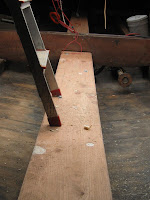 The forward legs of the ladder rest on the new cap that runs from the aft bulkhead through the midsection of the hull. The midsection is where the diesel motor will return to a reconstructed cradle.
The forward legs of the ladder rest on the new cap that runs from the aft bulkhead through the midsection of the hull. The midsection is where the diesel motor will return to a reconstructed cradle. Stabilizing members are replaced if necessary. Except for a few staves in the bow the hull is intact.
Stabilizing members are replaced if necessary. Except for a few staves in the bow the hull is intact.Rot, say the shipwrights, from the keel to the deck comes from fresh water gathering and seeping into the wood. Salt water acts as a wood preservative.
 The gaping hole in the foreground is where the fore cabin was removed to replace rotten decking around it and rot in the cabin itself.
The gaping hole in the foreground is where the fore cabin was removed to replace rotten decking around it and rot in the cabin itself. Facing forward from the wheel housing the ladder is obscured by the aft cabin , but the flashlight and broom are visible in both deck shots.
Facing forward from the wheel housing the ladder is obscured by the aft cabin , but the flashlight and broom are visible in both deck shots. The wheelhouse aft of the aft cabin.
The wheelhouse aft of the aft cabin.The Chesapeake Bay Field Lab is seeking venues to apply for additional grants and for donations to extend the restoration to the decking and exterior hull. They can be located at www.thebaylab.org
Thanks for reading.











